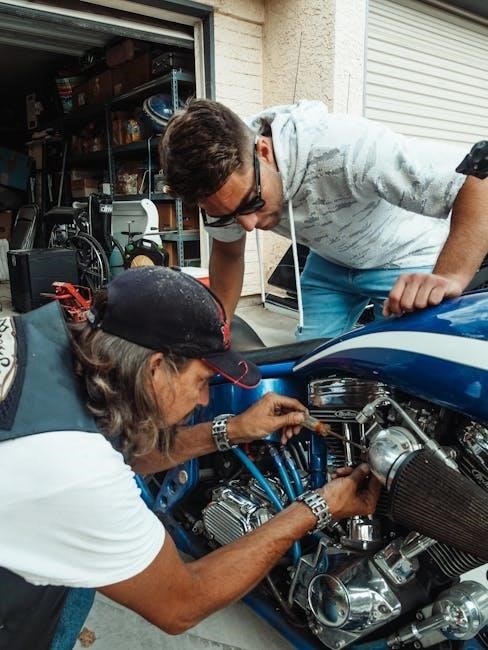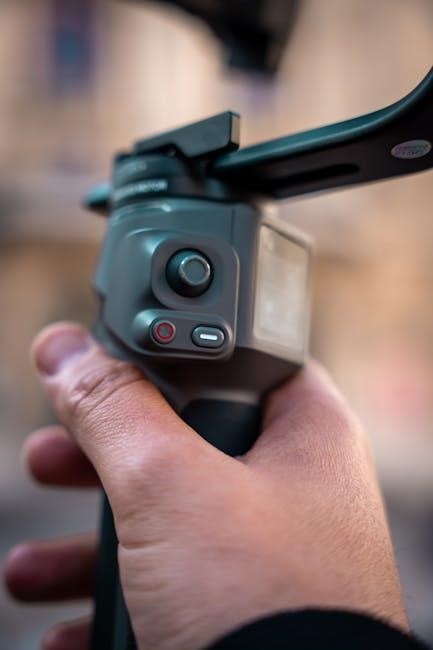The Hossfeld Bender is a versatile metal-bending tool widely used in fabrication, automotive, and education․ Its comprehensive manual ensures safe setup, operation, and maintenance, making it an invaluable resource for professionals and educators alike․
1․1 Overview of the Hossfeld Bender
The Hossfeld Bender is a versatile, high-performance tool designed for bending various materials, including round tubes, square tubes, and flat stock․ Known for its durability and precision, it is widely used in metal fabrication, automotive, aerospace, and educational settings․ The device supports both manual and hydraulic bending, offering flexibility for different applications․ Its universal design allows users to create complex shapes and angles with ease․ The comprehensive instruction manual provides detailed guidance on setup, operation, and maintenance, ensuring safe and efficient use․ This tool is ideal for professionals and educators seeking reliable, adaptable bending solutions across industries․
1․2 History and Development
The Hossfeld Bender has a long-standing history in metalworking, with its origins tracing back to the early 20th century․ Developed by Hossfeld Manufacturing, it quickly became a trusted tool in fabrication and industrial settings․ Over the years, the bender has undergone significant improvements, with advancements in hydraulic systems and precision engineering․ The instruction manual reflects this evolution, offering detailed guidance for optimal use․ Its reputation as a durable and versatile tool has made it a cornerstone in various industries, including automotive, aerospace, and education․ The Hossfeld Bender’s enduring popularity is a testament to its robust design and adaptability to modern manufacturing needs․
1․3 Types of Hossfeld Benders
Hossfeld Benders are available in various models, including the No․ 1, No․ 2, and Universal versions, each designed for specific applications․ The No․ 2 model is particularly popular for its versatility, accommodating round, square, and flat stock bending․ The Universal model offers advanced features for complex shapes․ Additionally, specialized dies like the 180 Tube Die expand the bender’s capabilities for precise 180-degree bends․ Instruction manuals provide detailed specifications and setup instructions for each model, ensuring users can maximize their tool’s potential․ Whether for basic or intricate bending tasks, Hossfeld offers a tailored solution, making it a favorite across industries․
The instruction manual is crucial for the safe and effective operation of the Hossfeld Bender․ It provides detailed guidance on setup, operation, and maintenance, ensuring optimal performance and longevity․ The manual covers essential topics such as safety precautions, bending techniques, and troubleshooting common issues․ By following the manual, users can avoid costly mistakes and maximize the tool’s potential․ Additionally, it serves as a valuable resource for educators, helping students understand metal-forming principles․ The comprehensive guide ensures that both professionals and novices can utilize the Hossfeld Bender efficiently, making it an indispensable companion for any project․

Safety Guidelines and Precautions
1․4 Importance of the Instruction Manual
The instruction manual is essential for the safe and effective operation of the Hossfeld Bender․ It provides detailed guidance on setup, operation, and maintenance, ensuring optimal performance and longevity․ The manual covers critical topics such as safety precautions, bending techniques, and troubleshooting common issues․ By following the manual, users can avoid costly mistakes and maximize the tool’s potential․ Additionally, it serves as a valuable resource for educators, helping students understand metal-forming principles․ The comprehensive guide ensures that both professionals and novices can utilize the Hossfeld Bender efficiently, making it an indispensable companion for any project․
2․1 General Safety Precautions
Operating the Hossfeld Bender requires strict adherence to safety guidelines to prevent accidents․ Always wear protective gear, including safety glasses and gloves, to safeguard against flying debris or machine malfunction․ Ensure the work area is clear of obstacles and loose clothing that could get caught in the machinery․ Properly secure the bender to a stable surface to maintain control during operation․ Never attempt to bend materials beyond the machine’s rated capacity, as this can lead to equipment damage or personal injury․ Familiarize yourself with the manual’s safety section before use and follow all recommended practices to ensure a safe working environment․
2;2 Emergency Procedures
In case of an emergency, immediately stop the Hossfeld Bender and disconnect the power supply to prevent further damage or injury․ For hydraulic fluid leaks, contain the spill and clean it up according to safety protocols․ If a material breaks during bending, carefully remove the damaged piece and inspect the machine for any damage․ In the event of mechanical failure, do not attempt to repair the bender while it is operational․ Always consult the instruction manual for specific emergency procedures․ Ensure all personnel are trained in these protocols to maintain a safe working environment and minimize risks during operation․
2․3 Protective Gear and Equipment
When operating the Hossfeld Bender, it is essential to wear appropriate protective gear to ensure safety․ This includes safety glasses or goggles to protect eyes from debris, steel-toe boots for foot protection, and gloves to prevent hand injuries․ Additionally, wear hearing protection if the machine generates excessive noise․ Avoid loose clothing or long hair that could get caught in moving parts․ Ensure all protective equipment meets workplace safety standards․ Proper training on equipment usage is also crucial to prevent accidents․ Always follow the manual’s guidelines for personal protective equipment (PPE) to maintain a safe working environment during bending operations․

Components of the Hossfeld Bender
The Hossfeld Bender comprises durable mechanical components, advanced hydraulic systems, and user-friendly control interfaces, each essential for precise and efficient metal bending operations․
3․1 Mechanical Components
The Hossfeld Bender features robust mechanical components designed for precision and durability․ Key elements include the bending frame, die sets, pins, and blocking systems․ The 9B Flat-Surface Roller and 11B Square Blocks are essential for shaping round and square tubes, as well as flat stock․ These components ensure accurate bends and versatility in handling various materials․ The mechanical setup is complemented by a user-friendly interface, allowing for easy adjustment and alignment․ Proper assembly and alignment of these parts, as detailed in the manual, are crucial for optimal performance and safety․ Regular inspection of mechanical components is recommended to maintain functionality and prevent wear․
3․2 Hydraulic Components
The hydraulic system of the Hossfeld Bender is integral to its operation, providing the power needed for precise metal bending․ This system includes a hydraulic pump, valves, and cylinders․ The pump ensures consistent pressure, while the valves control fluid flow, enabling smooth, controlled movements․ Hydraulic cylinders execute the bending action with force and accuracy․ Proper maintenance, such as checking fluid levels and replacing seals, is essential to prevent system failure․ The manual details procedures for hydraulic setup and troubleshooting, ensuring optimal performance and longevity of the equipment․ Regular lubrication of hydraulic components is also crucial for maintaining seamless functionality and preventing wear․
3․3 Control Systems and Interface
The Hossfeld Bender features a user-friendly control system designed for precision and ease of operation․ The control panel includes intuitive buttons or levers for initiating and adjusting bending operations․ Digital or analog interfaces provide real-time feedback on pressure, angle, and position, ensuring accurate results․ The system allows for pre-setting desired bends and storing frequently used configurations․ Emergency stop mechanisms are integrated for safety․ The interface is designed to minimize operator error, with clear indicators for system status and maintenance alerts․ Regular calibration of the control system, as outlined in the manual, is essential for maintaining accuracy and reliability over time․

Setting Up the Hossfeld Bender
Setting up the Hossfeld Bender involves assembling mechanical and hydraulic components, following the manual’s step-by-step guidance․ Initial calibration ensures precise bending operations and optimal performance, with safety emphasized throughout․
4․1 Mechanical Hardware Setup
Setting up the mechanical components of the Hossfeld Bender involves assembling the frame, pins, and blocks according to the manual․ Ensure all parts are properly aligned and securely fastened․ The manual provides detailed diagrams to guide the assembly process, emphasizing the importance of correct alignment for precise bending operations․ Properly installing the dies and rollers is critical to achieve accurate bends․ Always refer to the instruction manual for specific torque values and tightening sequences to prevent damage to the machine․ This step ensures the bender is ready for safe and efficient operation, with all mechanical components functioning as intended․ Safety checks should be performed after setup․
4․2 Hydraulic Hardware Setup
Setting up the hydraulic components of the Hossfeld Bender requires careful attention to detail․ Begin by installing the hydraulic cylinder and connecting the hoses to the appropriate ports․ Ensure all connections are secure to prevent leaks․ Refer to the manual for specific torque values when tightening fittings․ Next, check the hydraulic fluid level and top it off as needed, using the recommended fluid type․ Bleed the system to remove any air bubbles, which could cause inconsistent performance․ Finally, test the hydraulic system by cycling it several times to ensure smooth operation․ Proper setup is crucial for precise bending and long-term machine reliability․ Always follow the manual’s guidelines for optimal results․
4․3 Initial Calibration and Testing
Calibration and testing are essential to ensure the Hossfeld Bender operates accurately and safely․ Start by setting the hydraulic pressure according to the manual’s specifications․ Use a test piece of material to check the bending accuracy and adjust the dies as needed․ Perform a series of trial bends to verify consistency and precision․ Inspect the bends for any defects or irregularities․ If issues arise, consult the troubleshooting section of the manual․ Proper calibration ensures optimal performance and prevents costly errors during production․ Always follow the recommended testing procedures to guarantee reliable operation and achieve professional-grade results with your Hossfeld Bender․

Operating the Hossfeld Bender
Operating the Hossfeld Bender involves precise setup, adjusting dies, and following the manual’s bending techniques․ It excels at shaping round tubes, square tubes, and flat stock with ease and accuracy․
5․1 Basic Bending Techniques
Mastering basic bending techniques with the Hossfeld Bender is essential for achieving precise results․ Start by properly aligning the material with the die, ensuring it is securely positioned․ Use the 9B Flat-Surface Roller for flat stock and the 11B Square Blocks for square tubes․ Apply steady pressure while bending, following the manual’s guidelines for angle measurements․ Practice with round tubes to understand the machine’s response․ Always refer to the instruction manual for specific setups and adjustments․ Proper technique ensures safety, accuracy, and extends the tool’s lifespan․ Begin with simple bends to build confidence before tackling complex shapes․
5․2 Bending Round Tube and Square Tube
Bending round tube and square tube with the Hossfeld Bender requires precise alignment and proper die selection․ For round tubes, use the 9B Flat-Surface Roller to achieve smooth, consistent bends․ Square tubes benefit from the 11B Square Blocks, ensuring sharp, accurate corners․ Always secure the material firmly in the die to prevent slippage․ Start with small angles to test the machine’s response․ For square tubes, ensure the material is aligned with the die’s edges to maintain integrity․ Refer to the manual for specific die configurations and pressure settings․ Practice with different tube sizes to master the technique and achieve professional-grade results consistently․
5․3 Bending Flat Stock and Irregular Shapes
Bending flat stock and irregular shapes with the Hossfeld Bender requires careful setup and the right tooling․ Use the Flat-Face Radius Block for flat stock to achieve precise, repeatable bends․ For irregular shapes, employ custom dies or specialized tooling to accommodate unique geometries․ Ensure the material is securely positioned and aligned with the die edges․ Apply steady pressure and monitor the bend angle closely․ Small increments are key to avoiding distortion․ The Hossfeld Bender’s versatility shines with irregular shapes, allowing for complex bends when paired with the correct accessories․ Always refer to the manual for specific die configurations and safety tips when working with non-standard materials․

Advanced Bending Techniques
Explore specialized dies for precise control over complex angles and shapes․ Ideal for custom fabrication, the Hossfeld Bender excels in creating intricate bends with ease and accuracy․
6․1 Using Specialized Dies
Specialized dies enhance the Hossfeld Bender’s versatility, enabling precise control over complex angles and shapes․ These dies are designed for specific bending tasks, such as creating sharp corners or smooth curves․ By selecting the appropriate die, users can achieve consistent, high-quality results in various materials․ The manual provides detailed instructions on die installation and setup, ensuring optimal performance․ This feature is particularly valuable for custom fabrication projects, allowing professionals to meet exact specifications efficiently․ The ability to interchange dies makes the Hossfeld Bender a cost-effective solution for diverse metalworking needs, catering to both small-scale and industrial applications․
6․2 Bending with 180 Tube Die
The 180 Tube Die is a specialized attachment for the Hossfeld Bender, designed to create precise 180-degree bends in tubes and flat stock․ This die is ideal for applications requiring sharp, uniform folds, such as in automotive and aerospace industries․ Setup involves aligning the die with the bending axis and securing it firmly․ The manual provides step-by-step instructions for achieving accurate results, including tips for maintaining material integrity during extreme bending․ Proper lubrication and alignment are crucial to prevent damage to both the die and the workpiece․ This feature makes the Hossfeld Bender a valuable tool for complex fabrication tasks․
6․3 Creating Complex Shapes and Angles
The Hossfeld Bender excels in creating intricate shapes and precise angles, making it ideal for custom fabrication projects․ Using specialized dies, users can achieve complex bends, such as 180-degree folds or irregular contours․ The machine’s versatility allows for bending round tubes, square stock, and flat materials with ease․ By following the manual’s guidance on die alignment and setup, operators can produce consistent results․ Advanced techniques, such as multi-step bending, enable the creation of elaborate geometries․ This capability makes the Hossfeld Bender a preferred tool for industries requiring unique, high-precision metalwork, ensuring both functionality and aesthetic appeal in finished products․

Maintenance and Upkeep
Regular maintenance is crucial for optimal performance and longevity․ Lubricate moving parts, check hydraulic systems, and follow manual guidelines to prevent wear and tear effectively․
7․1 Routine Maintenance Procedures
Routine maintenance ensures the Hossfeld Bender operates efficiently and prolongs its lifespan․ Lubricate all moving parts regularly, inspect hydraulic fluid levels, and clean debris from the machine․ Check for wear on dies, pins, and rollers, replacing them as needed․ Refer to the instruction manual for specific lubrication points and fluid recommendations․ Daily inspections can prevent minor issues from becoming major problems․ Schedule monthly deep cleaning and component checks to maintain precision and performance․ Always follow the manufacturer’s guidelines for maintenance to ensure safety and optimal functionality․
7․2 Lubrication and Hydraulic Fluid Management
Lubrication is critical for maintaining the Hossfeld Bender’s performance and longevity․ Apply high-quality grease to all moving parts, such as pins and rollers, following the manual’s recommendations․ Hydraulic fluid levels must be checked regularly to ensure proper system operation․ Use only the specified type of hydraulic fluid to prevent damage․ Inspect for leaks and contamination, addressing issues promptly․ Clean or replace filters as needed to maintain fluid flow․ Regular lubrication and fluid management prevent wear, reduce downtime, and ensure precise bending operations․ Always refer to the instruction manual for specific guidelines on lubricants and fluid specifications․
7․3 Troubleshooting Common Issues
Troubleshooting the Hossfeld Bender involves identifying and addressing common issues promptly․ Low hydraulic fluid levels or contaminated fluid can cause poor performance․ Check for leakages and ensure all connections are secure․ If the machine fails to bend accurately, inspect the die alignment and ensure proper setup․ Worn or misaligned dies can lead to inconsistent results․ Refer to the manual for guidance on diagnosing and resolving these issues․ Regular maintenance, such as cleaning filters and lubricating moving parts, can prevent many problems․ For persistent issues, consult the instruction manual or contact Hossfeld support for assistance․

Accessories and Tooling
The Hossfeld Bender offers a range of accessories, including specialized dies, pins, and blocks, to enhance bending precision and versatility for various metalworking tasks and materials․
8․1 Available Tooling and Dies
The Hossfeld Bender offers a wide variety of tooling and dies, including flat-face radius blocks, square blocks, and specialized dies like the 180 Tube Die․ These tools are designed to handle different materials and bending requirements, ensuring precision and versatility․ The 9B Flat-Surface Roller and 11B Square Blocks are particularly popular for their ability to create accurate bends in round or square bars and flat stock․ Custom and specialized tooling options are also available to meet specific project needs, making the Hossfeld Bender adaptable for complex and unique bending tasks in metal fabrication․
8․2 Custom and Specialized Tooling
For unique bending requirements, the Hossfeld Bender offers custom and specialized tooling options․ These tailored solutions are designed to meet specific project needs, ensuring precise control over complex shapes and materials․ Users can collaborate with Hossfeld to create bespoke dies and tooling, optimized for particular bending tasks․ This customization enhances the bender’s versatility, allowing for intricate bends and specialized applications․ The process typically involves consulting with Hossfeld’s experts to design and fabricate the exact tooling required, ensuring compatibility and performance with the Hossfeld Bender․ This service is particularly valuable for fabricators and manufacturers dealing with unique or challenging bending projects;
8․3 Accessories for Enhanced Functionality
The Hossfeld Bender offers a range of accessories to enhance its functionality, ensuring precise and efficient bending operations․ These include specialized dies, radius blocks, and square blocks, designed to accommodate various bending needs․ The 180 Tube Die and Bulldozer Die are notable examples, enabling complex bends and square shapes․ Additional accessories like flat-stock dies and pin sets further expand the bender’s capabilities․ These tools are crafted to work seamlessly with the Hossfeld Bender, providing users with the flexibility to handle diverse materials and bending requirements․ By incorporating these accessories, users can optimize their bending operations and achieve superior results with ease and precision․

Parts and Diagrams
The Hossfeld Bender instruction manual includes a detailed parts list, schematics, and diagrams to help users identify components, understand assembly, and perform maintenance effectively․ These visuals ensure clarity and ease of use, making the manual an essential resource for both novice and experienced operators․
9․1 Detailed Parts List
The Hossfeld Bender manual provides an extensive parts list, ensuring users can identify and replace components easily․ Each part is listed with specific identifiers, descriptions, and corresponding page references for schematics․ This comprehensive catalog helps maintain and repair the bender efficiently․ The list includes mechanical, hydraulic, and control system components, ensuring no detail is overlooked․ Clear organization aids in quick reference, making maintenance straightforward․ Users can locate parts swiftly, minimizing downtime and ensuring optimal performance․ This detailed approach underscores the manual’s commitment to user support and machine longevity․
9․2 Schematics and Diagrams
The Hossfeld Bender manual includes detailed schematics and diagrams to guide users through assembly, operation, and maintenance․ These visuals provide a clear understanding of component relationships and proper setup․ Color-coded and labeled illustrations ensure accuracy in identifying parts and their functions․ Step-by-step diagrams simplify complex procedures, such as die installation and hydraulic system connections․ Troubleshooting sections are supported by visual aids, helping users diagnose and resolve issues efficiently․ The manual’s visual guides are essential for both novice and experienced users, ensuring safe and effective operation of the Hossfeld Bender․
- Assembly and setup visuals
- Hydraulic system diagrams
- Troubleshooting guides
9․3 Ordering Replacement Parts
The Hossfeld Bender manual provides a detailed parts list, making it easy to identify and order replacement components․ Users can contact Hossfeld Manufacturing directly via phone, fax, or email, using the provided contact information․ The manual includes model-specific part numbers, descriptions, and quantities, ensuring accurate orders․ Genuine parts are recommended to maintain machine performance and compatibility․ Orders can be placed through authorized distributors or directly from the manufacturer․ The manual also outlines return and warranty policies for defective parts, streamlining the replacement process; This ensures minimal downtime and keeps the Hossfeld Bender operating efficiently․
- Detailed parts list with model-specific information
- Contact details for Hossfeld Manufacturing
- Genuine parts recommendation
- Return and warranty policies

Industry Applications
The Hossfeld Bender is widely used in metal fabrication, automotive, and aerospace industries, as well as in educational institutions for training purposes․
10․1 Metal Fabrication and Manufacturing
The Hossfeld Bender is a cornerstone in metal fabrication and manufacturing, enabling precise bending of various materials․ Its versatility allows for bending round tubes, square tubes, flat stock, and irregular shapes, making it indispensable for creating custom components․ The instruction manual provides detailed guidance on setting up and operating the bender, ensuring accurate results․ Industries rely on its durability and reliability to streamline production processes․ Whether for crafting intricate parts or mass production, the Hossfeld Bender enhances efficiency and consistency, making it a vital tool in modern manufacturing workflows․
10․2 Automotive and Aerospace Industries
The Hossfeld Bender is widely utilized in the automotive and aerospace industries for its precision and versatility in bending metal components․ In automotive manufacturing, it is used for creating exhaust systems, suspension parts, and custom chassis components․ Aerospace applications often require bending high-strength, lightweight materials like aluminum and titanium, which the Hossfeld Bender handles efficiently․ The instruction manual provides detailed procedures for achieving accurate bends, ensuring compliance with strict industry standards․ Its reliability and adaptability make it an essential tool for fabricating complex shapes in both industries, contributing to innovation and efficiency in vehicle and aircraft production․
10․3 Educational and Training Institutions
Educational institutions widely adopt the Hossfeld Bender as a teaching tool for metal fabrication․ Its simplicity and effectiveness make it ideal for demonstrating basic bending principles․ Students learn to bend various materials, from round tubes to flat stock, using the machine’s versatile dies․ The instruction manual serves as a valuable resource for both instructors and learners, providing clear, step-by-step guidance․ This hands-on experience prepares students for real-world applications in industries like automotive and aerospace․ The Hossfeld Bender’s ease of use and comprehensive documentation make it an essential asset for vocational training and engineering education programs focused on metalworking skills․
The Hossfeld Bender is an indispensable tool for metal fabrication, supported by a comprehensive manual․ It guides users through setup, operation, and maintenance, ensuring optimal performance and adaptability across industries․
11․1 Summary of Key Points
The Hossfeld Bender is a versatile tool for metal fabrication, widely used in industries like automotive, aerospace, and manufacturing․ Its instruction manual provides detailed guidance on setup, operation, and maintenance, ensuring safe and efficient use․ The manual covers basic bending techniques, advanced methods, and troubleshooting, making it an essential resource for both professionals and educators․ By following the manual, users can achieve precise bends and complex shapes, leveraging the tool’s adaptability for various materials․ The Hossfeld Bender’s durability and ease of use make it a valuable asset in metalworking applications, supported by comprehensive instructional content․
11․2 Final Tips for Optimal Use
For optimal use of the Hossfeld Bender, always follow the instruction manual’s setup and maintenance guidelines․ Regularly lubricate moving parts and ensure hydraulic fluid levels are adequate․ Use the correct dies for specific tasks to achieve precise bends․ Practice basic techniques before attempting complex shapes, and refer to the manual for troubleshooting common issues․ Keep the tool clean and store it properly to maintain its longevity․ By adhering to these tips, users can maximize the bender’s performance and ensure safe, efficient operation across various metalworking applications․
11․3 References and Further Reading
For further understanding, refer to the Hossfeld Universal No․ 2 Bender Instruction Manual, available as a PDF download, which covers setup, maintenance, and advanced techniques․ Additional resources include the Hossfeld Bender Tooling Brochure and the Art of Bending guide from DiAcro․ Vintage Machinery and Hossfeld Manufacturing’s official website offer historical documents, parts lists, and schematics․ These materials provide in-depth insights into optimizing the Hossfeld Bender for various applications, ensuring users maximize its potential in metal fabrication and beyond․




